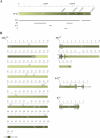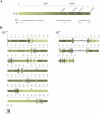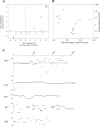Generation and evolutionary fate of insertions of organelle DNA in the nuclear genomes of flowering plants
- PMID: 15867426
- PMCID: PMC1088290
- DOI: 10.1101/gr.3788705
Generation and evolutionary fate of insertions of organelle DNA in the nuclear genomes of flowering plants
Abstract
Nuclear genomes are exposed to a continuous influx of DNA from mitochondria and plastids. We have characterized the structure of approximately 750 kb of organelle DNA, distributed among 13 loci, in the nuclear genomes of Arabidopsis and rice. These segments are large and migrated to the nucleus quite recently, allowing us to reconstruct their evolution. Two general types of nuclear insertions coexist; one is characterized by long sequence stretches that are colinear with organelle DNA, the other type consists of mosaics of organelle DNA, often derived from both plastids and mitochondria. The levels of sequence divergence of the two types exclude their common descent, implying that at least two independent modes of DNA transfer from organelle to nucleus operate. The post-integration fate of organelle DNA is characterized by a predominance of transition mutations, associated with the gradual amelioration of the integrated sequence to the nucleotide composition of the host chromosome. Deletion of organelle DNA at these loci is essentially balanced by insertions of nonorganelle DNA. Deletions are associated with the removal of DNA between perfect repeats, indicating that they originate by replication slippage.
Figures





Similar articles
-
Mutational decay and age of chloroplast and mitochondrial genomes transferred recently to angiosperm nuclear chromosomes.Plant Physiol. 2005 Jul;138(3):1723-33. doi: 10.1104/pp.105.060327. Epub 2005 Jun 10. Plant Physiol. 2005. PMID: 15951485 Free PMC article.
-
Abundance of plastid DNA insertions in nuclear genomes of rice and Arabidopsis.Plant Mol Biol. 2003 Jul;52(5):923-34. doi: 10.1023/a:1025472709537. Plant Mol Biol. 2003. PMID: 14558655
-
Continuous infiltration and evolutionary trajectory of nuclear organelle DNA in Oryza.Genome Res. 2025 Jun 2;35(6):1349-1363. doi: 10.1101/gr.279609.124. Genome Res. 2025. PMID: 40280772
-
Nuclear Integrants of Organellar DNA Contribute to Genome Structure and Evolution in Plants.Int J Mol Sci. 2020 Jan 21;21(3):707. doi: 10.3390/ijms21030707. Int J Mol Sci. 2020. PMID: 31973163 Free PMC article. Review.
-
Origin, evolution and genetic effects of nuclear insertions of organelle DNA.Trends Genet. 2005 Dec;21(12):655-63. doi: 10.1016/j.tig.2005.09.004. Epub 2005 Oct 10. Trends Genet. 2005. PMID: 16216380 Review.
Cited by
-
Environmental stress increases the entry of cytoplasmic organellar DNA into the nucleus in plants.Proc Natl Acad Sci U S A. 2012 Feb 14;109(7):2444-8. doi: 10.1073/pnas.1117890109. Epub 2012 Jan 30. Proc Natl Acad Sci U S A. 2012. PMID: 22308419 Free PMC article.
-
Organellar genome analysis reveals endosymbiotic gene transfers in tomato.PLoS One. 2018 Sep 5;13(9):e0202279. doi: 10.1371/journal.pone.0202279. eCollection 2018. PLoS One. 2018. PMID: 30183712 Free PMC article.
-
Mitochondrial DNA transfer to the nucleus generates extensive insertion site variation in maize.Genetics. 2008 Jan;178(1):47-55. doi: 10.1534/genetics.107.079624. Genetics. 2008. PMID: 18202357 Free PMC article.
-
Nuclear DNA segments homologous to mitochondrial DNA are obstacles for detecting heteroplasmy in sugar beet (Beta vulgaris L.).PLoS One. 2023 Aug 8;18(8):e0285430. doi: 10.1371/journal.pone.0285430. eCollection 2023. PLoS One. 2023. PMID: 37552681 Free PMC article.
-
Chimeric deletion mutation of rpoC2 underlies the leaf-patterning of Clivia miniata var. variegata.Plant Cell Rep. 2023 Sep;42(9):1419-1431. doi: 10.1007/s00299-023-03039-0. Epub 2023 Jun 16. Plant Cell Rep. 2023. PMID: 37326841
References
-
- Adams, K.L. and Palmer, J.D. 2003. Evolution of mitochondrial gene content: Gene loss and transfer to the nucleus. Mol. Phylogenet. Evol. 29: 380–395. - PubMed
-
- Adams, K.L., Daley, D.O., Qiu, Y.L., Whelan, J., and Palmer, J.D. 2000. Repeated, recent and diverse transfers of a mitochondrial gene to the nucleus in flowering plants. Nature 408: 354–357. - PubMed
-
- Altschul, S.F., Gish, W., Miller, W., Myers, E.W., and Lipman, D.J. 1990. Basic local alignment search tool. J. Mol. Biol. 215: 403–410. - PubMed
-
- Ayliffe, M.A., Scott, N.S., and Timmis, J.N. 1998. Analysis of plastid DNA-like sequences within the nuclear genomes of higher plants. Mol. Biol. Evol. 15: 738–745. - PubMed
Web site references
Publication types
MeSH terms
Substances
LinkOut - more resources
Full Text Sources
